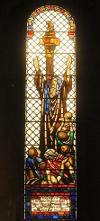Harry Ranken VC
Their names will be remembered for evermore
The first Glaswegian to receive the Victoria Cross showed bravery typical of soldiers who put their own safety aside for fierce loyalty to their "chums".
An army doctor who was one of the first nine recipients of the VC gave his life for his patients. Putting others' injuries first after a shell attack, Captain Harry Ranken continued to treat them after his own leg was almost severed. He was one of the first casualties of the war himself, and in his death the world of medicine lost someone who had at age 31 already made important discoveries in the field of tropical diseases.
Ranken joined the Royal Army Medical Corps before the war, and at the outbreak volunteered for service with the 1st Battalion, The King's Royal Rifle Corps. Within days of arriving in Normandy, France, on 13 August, 1914, Ranken was made a Chevalier of the French Legion of Honour for gallantry under fire. The Battle of Aisne began shortly afterwards.
Terrible Injuries
On 19 September, the Rifles were at Hautes-Avesnes. The awful power of shellfire was becoming apparent to the medical world, with victims suffering blindness, lung damage and death without apparent external injuries. Ironically, Ranken was seriously wounded by a British shell. He got combat officers to bind his leg wound, and carried on working.
He would not allow his own case to be prioritised over others. After a day tending the wounded, Rankin allowed himself to be evacuated from the front line in stages. He was taken to a dressing station by stretcher, then to a clearing hospital, and had his leg amputated. A witness remembered seeing him on a stretcher at Braisne railway station, talking and comfortable, but Ranken died of a blood clot soon after.
Huge Loss of Talent
Ranken's VC was announced in the war's first list of the honours, on 16 November, 1914. The citation reads: "For tending wounded in the trenches under rifle and shrapnel fire and on 20 September continuing to attend to wounded after his thigh and leg had been shattered." His early talent was well-known and the loss of potential to the medical world was frequently mentioned in tributes.
He had won several prizes while a student at Glasgow medical school at the University of Glasgow. He had taken first place in the entry exam for the Royal Army Medical Corps in 1909. While with the RAMC he won prizes in hygiene, military and tropical medicine. He became an assistant to prominent pathologists, and published jointly on new treatments for the deadly parasitic disease African sleeping sickness.
Ranken was also attached to the Egyptian Army in 1911, and while using a metallic intravenous treatment for sleeping sickness, discovered it was also effective against yaws, an infectious and disfiguring skin condition.
Ranken was born in Maryhill, the son of the Rev Henry Rankin, parish minister of Irvine. After their son's death, his parents founded a prize in his memory for Glasgow pathology students. The Queen Elizabeth Hospital in London, part of the Brook Fever Hospital where Ranken was assistant medical officer, named one building Ranken House, and in his home town of Irvine, Ranken Crescent and Ranken Drive carry his name on.
He is buried in Braine Communal Cemetery in France. He was also remembered by the Western Infirmary, his first employer, with a stained glass window commemorating 22 of its doctors who gave their lives in the war.
The RAMC has Ranken's medals and sword, which was worn by an officer of the Guard of Honour for its 60th anniversary service at St Paul's Cathedral in 1958.
View original referenced text here:Harry Ranken VC (PDF, 134 KB)(opens new window)
Images:
- A photograph supplied by Ranken's father to the British Medical Journal for his obituary. Credit: University of Glasgow Archive Services, University Chapel collection, GB0248, Ch 4/4/2/2/226.
- Ranken was included in numerous issues of cigarette cards, which featured portraits of current war heroes. This picture 'cheats' by showing him wearing an award granted after his death. Credit: Private Collection.
- A wartime postcard showing an artist's version of Harry Ranken tending his patients while under fire, and wounded himself. Credit: Private Collection.
- Stained glass memorial.









